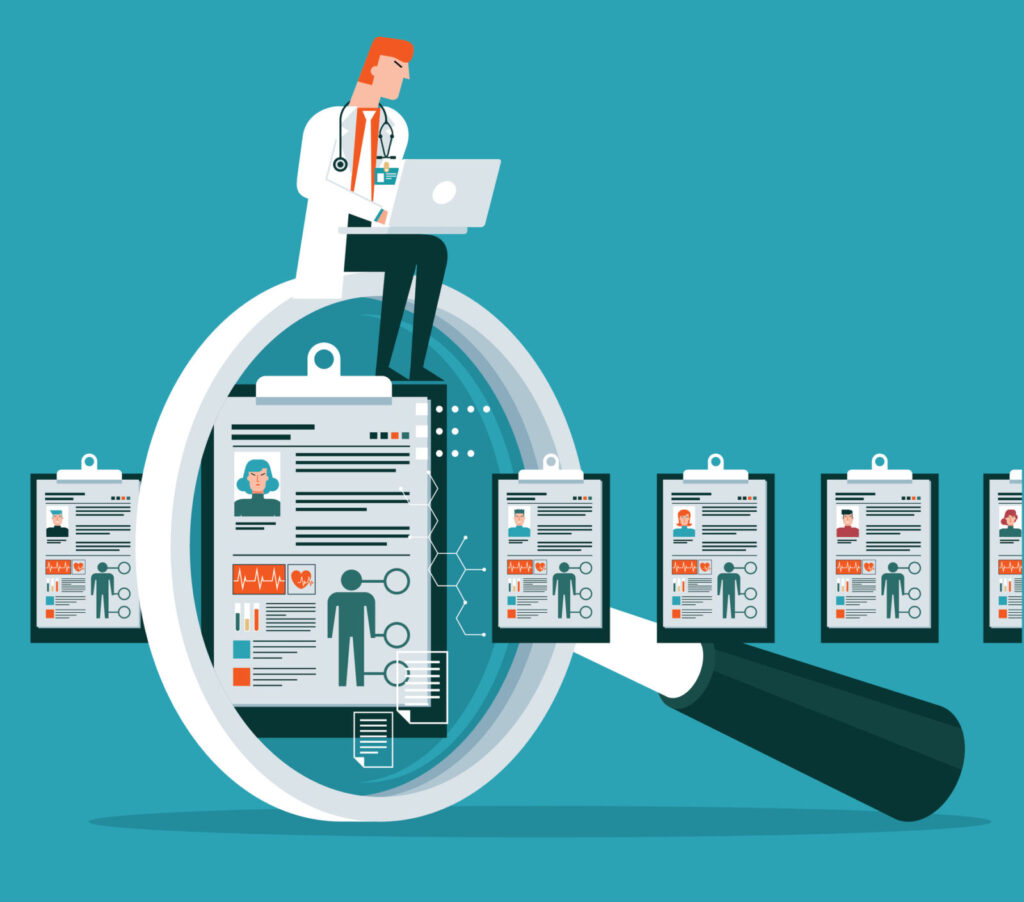
“Sitting on a gold mine.” That expression may hit home for healthcare organizations that have yet to begin extracting full value from their rich data collections. Are your data actionable, teaching you what you need to know so you can do what needs to be done? Can all those statistics and metrics be assembled into a solid base from which to:
- Launch on-target preventive care efforts?
- Create well-timed interventions?
- Tailor individual care plans?
- Address the needs of specific populations?
- Streamline administrative processes and reduce waste?
Your troves of information, properly harnessed, will reveal fresh insights into the needs and the lives of the people entrusted to your care. They also will suggest viable options for meeting those needs and improving those lives. But there’s way too much information to be digested without digital assistance.
Today’s technologies facilitate the collection, organization, interpretation and analysis of vast seams of data. Medical, dental and surgical records. Hospital records. Medical exam results. Behavioral data. Living conditions. Biometrics such as fingerprint, face, iris and voice. The array of available data sources includes electronic health records (EHRs), patient portals, wearable devices, surveys and focus groups, research studies, government agencies, generic databases and more.
These reservoirs of information can generate essential guidance in developing care plans, discovering patterns and trends, predicting and preparing for pandemics and other crises, and delivering a superior overall patient experience. Tools such as analytics and predictive modeling, for example, can inform proactive decisions about when, where, how and why to provide care—contributing to positive outcomes while reducing avoidable readmissions, unnecessary tests and procedures, and other waste.
Healthcare organizations must hone their ability to meaningfully tap into the data within their reach. To be as actionable as possible, healthcare data should be predictive, prescriptive and personalized, working together to inform providers, educate patients and guide care.
Descriptive, Predictive and Prescriptive Analytics
There are three main components to business analytics, as detailed by Business News Daily. Descriptive analytics summarizes raw data, which in healthcare might include patient statistics and engagement counts. Predictive analytics forecasts potential outcomes stemming from descriptive data.
Prescriptive analytics, the most complex of the three types, scrutinizes those outcomes and offers recommendations for how to proceed—such as identifying and stratifying risk or pinpointing gaps in care. It uses mathematical algorithms, artificial intelligence (AI) and machine learning to uncover options for next best actions to address the challenge at hand. For example, predictive analytics and modeling can help determine which patients are more likely to adhere to medication regimens or act on their own to close care gaps, and which might require interventions.
Whether you are seeking insights on the condition and treatment of an individual patient or a defined population, both predictive and prescriptive analytics should be key tools to help your organization develop a strategy. Which populations, for example, are the most expensive to care for, and which should be targeted first with interventions?
Personalization and Engagement
There’s a heightened focus these days on patient engagement, which cannot be mastered without personalization. Consumers “spoiled” by customized treatment from the retail, travel, hospitality and entertainment industries now expect no less from their healthcare. For starters, they want ready access to information that is personally relevant, transparent and easy to understand. They want to be treated by empathetic physicians and staff who show they care by getting to know a little about them. And how about a personalized health assessment, along with a personalized disease management and wellness plan?
Data sharing, of course, is a two-way street. The more information patients share with their providers, the more information becomes available for diagnosing and creating treatment plans not only for them, but also for others with the same or similar diseases or conditions. Details and nuances matter. Analytics tools can uncover patterns suggesting new approaches.
Truly Actionable Healthcare Data
Like data sharing, the action in actionable data is also a two-way street. The patient must share responsibility for the outcome. Adherence to a medication, rehabilitation or dietary regimen, for example, is often essential to avoiding unnecessary hospital readmissions. Personalization makes it easier to achieve the engagement necessary to involve patients in their own well-being. It also helps caregivers glean insights into social determinants of health (SDOH) and other nonmedical factors that might be affecting a patient’s health.
Personalization is about the medium as well as the message. That means engaging with patients or members through their preferred channel(s)—email, text, app, automated phone call, etc.—to keep them connected, informed and involved.
Strategies for Harnessing Your Data
From individual care to population health, here are five broad strategies for recognizing the power of your data and then harnessing it.
- Take a holistic view. Treat patients not as statistics but as unique individuals with whole lives much bigger than their disease or diagnosis. Because the conditions in which they live and work often play significant roles in their health, pay attention to SDOH and other issues that might shed light on a situation. For example, a patient lacking transportation to the pharmacy will have difficulty adhering to a medication regimen. Some patients require education about the physical, mental and financial ramifications of their condition, as well as their own responsibilities in achieving the desired outcome, so keep health literacy in mind.
- Commit to the long term. Patients, especially those with chronic or complex conditions, need someone they can depend on throughout the patient journey. Medical histories are important, and so is predictive modeling that can alert physicians to potential future problems.
- Share information. Many patients see multiple providers for multiple conditions. When these caregivers operate in silos or vacuums, the result is fragmented care. Truly integrated care calls for connection, communication, coordination and cooperation. It uses data to connect patient and providers; bring together physical, mental and behavioral health; and link hospital, pharmacy, rehabilitation and home care.
- Segment and micro-target populations. The goal of healthcare access for all demands the closing of gaps in care, especially for our most vulnerable populations: the very young and very old, racial and ethnic minorities, people with chronic and complex conditions and comorbidities, those living in poverty. Depending on the demographics of the populations you serve, you can use data to detect the groups most in need of immediate attention: for example, expectant mothers at risk of delivering low-birthweight babies.
- Employ the right technologies. To reap the maximum benefits from your data, you need digital platforms that will link data with systems and processes, incorporating it into the workflow where it can be easily accessed by all who need it. Useful auxiliary tools include telemedicine as well as wearable devices that record patient heart rates, activity levels, sleep patterns and other biometric data. Such tools can increase patient engagement, ease communication between patients and their providers, and reduce the need for in-person visits. And biometrics tools are more important than ever, helping to ensure accurate patient identification, monitoring and privacy.
The information you need is within reach. Powerful tools for harvesting and leveraging the data are also available. It’s time to go for the gold.



About The Author: Medecision
Fully delivering on the promise of data — and making the business of healthcare simpler and more successful — Medecision offers a whole new world of possibilities. The company's flagship offering, Aerial™, stands as the market's most extensible clinical data platform. It offers complete contextual awareness of members and automates next best actions — simple campaigns, complex care management, utilization approvals, and more — for optimal health outcomes.
Aerial is not only quick to deploy, it is easy to manage. The platform's effectiveness in reducing both medical and administrative costs, coupled with its role in improving the member and patient experience, has made it the preferred choice for health plans and care delivery organizations. Presently, Aerial is instrumental in catering to over 10% of the U.S. population, marking a significant milestone in advancing healthcare efficiency and effectiveness.
More posts by Medecision